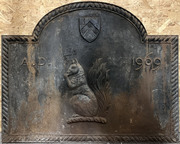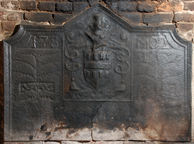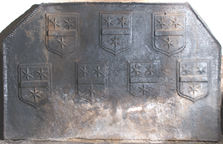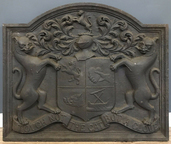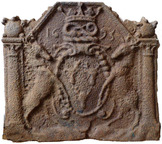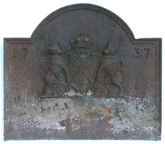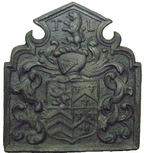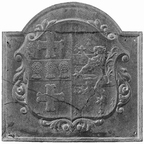-
1257
Description: Arched rectangular shape, edged with simulated twisted rope between two fillets; in the arch, a shield: argent on a chevron gules three roses of the field, a canton gules for difference; beneath the shield a crest: on a wreath a squirrel sejant gules cracking a nut gules, charged on the shoulder with a cross crosslet gold for difference; inscription split either side of the head of the squirrel.
Notes: A finely modelled and cast modern fireback with the arms and crest of a direct descendant of John Davies Gilbert (1811-54) who had played a major role in the development of the town of Eastbourne and also developed Trelissick Garden in Feock, Cornwall.
Inscription: A.D. 1969
Arms: Gilbert, of Eastbourne, Sussex, and Trelissick, Cornwall
- Decoration tags:
- rectangular with round arch (shape)
- fillet (edging)
- whole carved pattern
- heraldic
- armorial
- text
- animals
Manufactured: in 1969 in England.
Current location: noit known.
- Attached to series:
- Personal armorial firebacks
-
700
Description: Cavetto-canted rectangle with central pediment; cyma-reversa moulded edging; central pedimented panel, fillet edged, with shield, helm, crest and mantling of the May family; on either side, an incised floral pattern of a stem and six branches, rising from a rectangular, low-relief panel of two images of horsemen; above, the inscription in low relief.
Notes: The arms of May: Gules, a fess between eight billets Or; crest: Out of a ducal coronet Or, a lion’s head gules bezanty; the same armorial stamp appears to have been used on an unnamed iron graveslab in Ticehurst church. The initials are probably those of Susanna May (c1653-1718), heir to Pashley, in Ticehurst, who had married her distant cousin, Sir Robert May, in 1686. The May family had been involved in the iron industry in the 16th and early 17th centuries, but were no longer active a century later. Incised decoration on firebacks is uncommon, the decoration probably having been incised into the pattern board.
Inscription: 17S M02
Arms: May of Pashley, Ticehurst
- Decoration tags:
- rectangular with canted top corners and triangular arch (shape)
- cyma reversa/ogee (edging)
- carved stamps
- whole carved pattern
- armorial
- text
- animals
- humans
Manufactured: in 1702 in the Weald area of England.
Current location: in private hands, Ticehurst, East Sussex, England.
- Attached to series:
- Personal armorial firebacks
-
722
Description: Canted rectangular shape; twisted rope edging (top and sides); shield with recessed edges repeated seven times (3 and 4): a fess between three mullets of six points.
Notes: The arms are those of Courthope of Whiligh in Ticehurst; blazon: argent, a fess azure between three estoiles sable (two and one). Shown are molets of six points which have straight rays instead of (properly) estoiles which have wavy ones. However, the 1643/4 iron graveslab of David Barham of Snape, in Wadhurst church, has the same arms (also with molets instead of estoiles), which were those of his mother who was a Courthope.
Arms: Courthope, of Whiligh in Ticehurst
- Decoration tags:
- rectangular with canted top corners (shape)
- rope (edging)
- carved stamps
- heraldic
- armorial
Manufactured: in the late-16th to early-17th century in the Weald area of England.
Current location: in private hands, Ticehurst, East Sussex, England.
- Attached to series:
- Personal armorial firebacks
- Courthope arms series
-
1145
Description: Arched rectangular shape; stepped cavetto-moulded edging; shiled, suporters, helm, crest, mantling and motto of Clan MacIntosh
Notes: Blazon: Quarterly, 1st, Or, a lion rampant, Gules, armed and langued, Azure (for MacDuff); 2nd, Argent, a dexter hand, couped, fessways, grasping a man’s heart, paleways, Gules; 3rd, Azure, a boar’s head, couped, armed, Proper, and langued, Gules; 4th, Or, a lymphad, sails furled, Azure, flagged and surmounted of her oars in saltire, Gules (for Clan Chattan). The motto means 'Don't touch the cat without a glove'.
Inscription: TOUCH NOT THE CAT BOT A GLOVE
Arms: Clan MacIntosh
- Decoration tags:
- rectangular with round arch (shape)
- stepped cavetto (edging)
- whole carved pattern
- heraldic
- armorial
Manufactured: in the 20th century .
Current location: not known.
- Attached to series:
- Personal armorial firebacks
-
818
Description: Quasi-arched rectangular shape; on a ground, an armorial achievement comprising a central cartouche on which is an oval shield bearing the arms of the Cavendish family, with graduated bead edging; supporters, two stags rampant; above the cartouche, on a wreath a coiled snake crest surmounted by an earl’s coronet; the date split either side of the crest; to each side, a column with foliate capital supporting a three-sided arch with ovolo-moulded edging, on each shoulder of which is a flaming orb.
Notes: The arms are those of the Earls of Devonshire. However, the date relates to William Cavendish (1640-1707), previously 4th Earl and created 1st Duke of Devonshire in 1694. An earlier casting (no. 246) has a date of 1657, the second pair of numerals having been changed. Christie's auction 3 Dec 2014 lot 15 (dated incorrectly as 1693) (£1,875).
Inscription: 1695
Arms: William Cavendish, 1st Duke of Devonshire, as 4th Earl of Devonshire
- Decoration tags:
- rectangular with three-facetted arch (shape)
- complex individual (edging)
- whole carved pattern
- individual numbers
- armorial
- text
Manufactured: in 1695 in England.
Current location: not known.
- Attached to series:
- Personal armorial firebacks
- Cavendish arms series
-
819
Description: Arched rectangular shape; cavetto moulding (top and sides); date in top corners; shield, supporters, coronet and motto of the Barony of Bergavenny.
Notes: The arms are those of William Nevill, 16th Baron Bergavenny, of Kidbrooke Park, Forest Row, Sussex; the arms have been modified by the omission of the motto below the compartment.
Inscription: 17 37
Arms: William Nevill, 16th Baron Bergavenny
- Decoration tags:
- rectangular with round arch (shape)
- cavetto (edging)
- carved stamps
- individual numbers
- armorial
- text
Manufactured: in 1737 in the Weald area of England.
Current location: in private hands, Greenham, Somerset, England.
- Attached to series:
- Bergavenny firebacks
- Personal armorial firebacks
-
877
Description: Low arched rectangle; astragal and stepped fillet edging; slanted shield, helm and mantling; crest missing; at bottom, date split either side of shield.
Notes: The arms are of the Pollen family of Redenham, Hampshire; blazon: azure, on a bend cotised or between six lozenges argent each charged with an escallop sable, five escallops vert.
Inscription: 19 27
Arms: Pollen of Andover, Hampshire
- Decoration tags:
- rectangular with round arch (shape)
- astragal and stepped fillet (edging)
- whole carved pattern
- armorial
Manufactured: in 1927 in England.
Current location: not known.
- Attached to series:
- Personal armorial firebacks
-
908
Description: Quasi arched rectangular shape with detached pediment above symmetrical ‘horns’ within arcs; cavetto-moulded edging; shield with helm, crest and mantling; initials split by crest.
Notes: Blazon: quarterly 1st lion rampant (poss. Lewis, descendant of Gwaethfoed); 2nd a chevron between three fleurs de lys (descendant of Einon ap Collwyn); 3rd three chevronels (descendant of Iestyn ap Gwrgan); 4th as 2nd (but possibly different tinctures); crest: a lion rampant; the initials suggest the arms may be of a member of a cadet branch of the Lewis family.
Inscription: T L
Arms: Possibly a member of the Lewis family
- Decoration tags:
- rectangular with detached pediment (shape)
- cavetto (edging)
- whole carved pattern
- armorial
- text
Manufactured: in the late-16th to early-17th century in Wales.
Current location: Ty-r-ash, Brecon Road, Crickhowell, Powys, Wales.
- Attached to series:
- Personal armorial firebacks
- Welsh armorial firebacks
-
1054
Description: Arched rectangular shape; chamfered edging; 'renaissance' style shield with floriate decoration; incised heraldic design.
Notes: The arms are of Sir John Herbert Vernon Bt. impaling those of his wife, Elizabeth Bagnall; Blazon: (Vernon) Or, on a fess azure between two crosses moline gules three garbs of the field, a canton of a baronet; (Bagnall) Ermine, two bars or, over all a lion rampant azure. The fireback dates from between 1919, when Sir John inherited the baronetcy and his death in 1933.
Arms: Vernon impaling Bagnall
- Decoration tags:
- rectangular with round arch (shape)
- chamfered (edging)
- whole carved pattern
- heraldic
- armorial
Manufactured: in the early-20th century in England.
Current location: not known.
- Attached to series:
- Personal armorial firebacks
-
1264
Description: Arched rectangular central panel with bead edging (top and sides) enclosing a shield, helm, crest, mantling and motto of the Fitch family, descendants of Edwin Frederick Fitch (1839-1916); above the achievement, symmetrical laurel leaves, all within an arched rectangular astragal border surmounted by, on the dexter side, a behelmeted merman holding a scimitar and, on the sinister side, a mermaid holding a mirror; top centre, three ostrich feathers gathered with a ribbon.
Notes: A pastiche of the 17th century Carolean 'Dutch' series (e.g. no. 280). Blazon: Vert, on a chevron between three leopards' faces or langued gules, as many cross crosslets fitchee of the last, in the chief point an ermine spot of the second; Crest: Upon a wreath of the colours, a leopard's face erminois pierced through the mouth with a sword broken in the middle argent, pommel and hilt or.
Inscription: FACTA NON VERBA [Actions not words]
Arms: Fitch
Manufactured: in the early- to mid-20th century in England.
Current location: not known.
- Attached to series:
- Personal armorial firebacks
